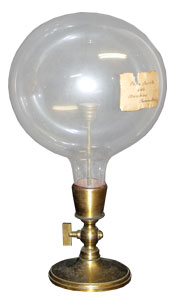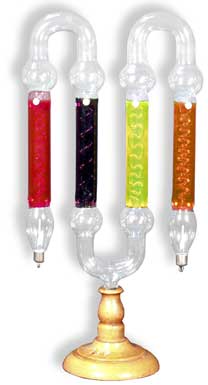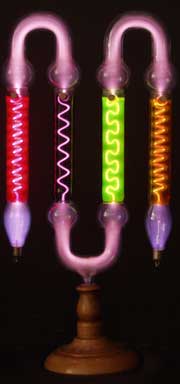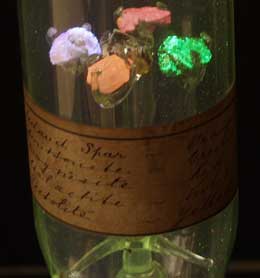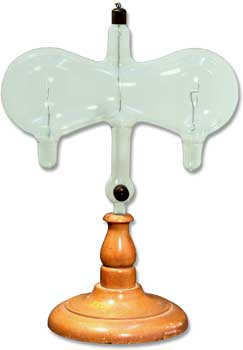| Contact |
| Back | Next | Home |
|
|
|
||||
|
Born in the village of Igelshieb, in the Rennsteig area of the Dukedom of Saxony-Meiningen, Geissler is a well known figure in the history of scientific instruments since the descendants of his inventions - the Geissler tube and the mercury vacuum pump are still in use today. Igelshieb is a suburb of Neuhaus am Rennweg in the state of Thuringia, Germany. The house of birth of Geissler is still there and contains a nice collection of Geissler tubes and those of other plasma heroes. This is organized by the Förderverein Heimatmuseum Geissler - Haus e.V. with its president Rolf Schöler in Neuhaus, available at sylvia.schoeler@web.de . Geissler's father Georg was an innovative glass-blower and maker of instruments such as barometers and thermometers. Heinrich Geissler's youth coincided with a flowering in interest in experimental natural sciences leading to a greater demand for laboratory apparatus, particularly hollow glassware, which was to catapult the craft of the glassblower from a cottage industry to a profession. Geissler, however, earned his living for a decade as a traveling instrument maker before settling and establishing a workshop in Bonn, a young university town with a demand for laboratory apparatus. Here Geissler worked closely with chemists, physicists, medical doctors, physiologists and mineralogists and built up an international client list. From 1855 he participated regularly in world exhibitions, winning several medals for his scientific apparatus. Geissler began experimenting with what were later to become known as the 'Geissler tube' in 1857 and full-scale production of these was well underway in the 1880s. He died in 1879 and is buried in Bonn. Source: Christie's,
Mason & Woods Ltd. |
Active in chemical and physical research for more than fifty years, William Crookes was trained in science by Faraday, Wheatstone and Stokes. He was knighted in 1897 and awarded the Order of Merit in 1910, for his contribution to scientific research. For most of his life he was a freelance chemical consultant, using a home laboratory.
He produced a vacuum of one
millionth of an atmosphere, thus making possible the discovery of X-rays
and the electron. He also experimented on cathode rays - streams of
negatively-charged particles - now called electrons. These are released
from the surface of a metal plate called the cathode and fixed in a
vacuum within a glass tube.
In 1878, Crookes became convinced
that the dark space he has observed between the cathode and the glow,
extended farther from the cathode as the pressure inside the glass tube
was reduced. The pressure could be reached to the point at which the
dark space touched the far end of the tube opposite the cathode. This
suggested that the electrical discharge in an evacuated tube was an
actual illumination of the lines of molecular pressure.
He produced special tubes to
examine cathode rays at various configurations and gas pressures. He
discovered that a bar magnet contorts the rays into a spiral, while a
horseshoe magnet produced a curve.
|
||||
|
|
Single barrel air pump on mahogany base measuring 20" x 11-3/4" and 28" at highest point. Belljar measures 17" high and 6-3/4" in diameter. See page 7, figure 4 in A Catalog of Pneumatic Instruments Manufactured and Sold by N.B. and D. Chamberlain, Boston 1844. Very Fine Condition. American, circa 1860's.. Also with air pump are included: another glass belljar measuring 12-3/4" high, * diameter; a third glass belljar measuring 15" high, 8-1/2" diameter; a fourth (also known as "Hand Glass" see Pike's Catalog Vol. I pg 201 fig. 191) or "Swelled open - top bell-glass" (see pg. 15, fig. 24 in N. B. and Chamberlain's Catalog) measuring 6" high, 5-5/8" diameter; a set of "Hemispherical Cups", (see pg. 17, fig. 33 in Chamberlain's Catalog) (also known as "Magdeburg" Hemisphere (see Pike's Catalog Vol. I pg. 203-204 fig. 197) made of brass and 3-1/8" in diameter; and a Fountain- in-Vacu (see pg. 28-29, fig 58 in Chamberlain's Catalog) or Artificial Fountain, made of glass and is 23" in height; signed on the stopcock "JAS. W. Queen, Phila". All the above accessories are in fine condition and are American, circa 1860's. |
||||
Geissler tubes were constructed in many very creative shapes and sizes. It is not uncommon to find tubes with elaborate twisted swirls or colored water chambers. The tubes can be quite striking when activated. Below are some examples of the tubes (Geissler and Crookes tubes) that I have in my collection, some dating back to about 1868: |
|||||
An exceptionally rare multi-bulb Geissler tube
containing four different fluorescent fluids: Rhodanine, Eosine,
Flourecine, and Authacein. |
|||||
| |
|
|
 |
To the right and left are Crookes cathode-ray tubes. The cathode-rays (streams of electrons) can be clearly seen. |
 |
|
|
|
|
Another Newton's Egg
|
||
|
|
|
||||
|
|
|
|
Crookes Fluorescent |
||
|
|
|
|
|||
|
|
|
|
|||
|
|
|
|
|||
|
CROOKES VACUUM TUBE This tube is used to demonstrate the effect of vacuum on radiant matter. See illustration at right. Two tubes are placed side by side, identical except that the first tube contains a low vacuum, while the second contains a high vacuum. In the first tube, radiant matter will be seen reaching from the cathode to whichever electrodes are connected to a positive supply. In the second tube, the radiant matter travels in straight lines from the cathode, causing fluorescence of the walls of the tube directly opposite.
|
|
||||
|
|
|
||||
|
The hollow, tapered glass tube is 26" in height and is supported on a turned mahogany base which measures 8-1/4" in diameter. Described and illustrated in Pike's Catalog Vol. I on page 205, fig. 200 and also in N.B. and D. Chamerlain's Catalog on pages 28-29, fig. 58. |
On mahogany turned base 7" diameter; the hollow glass tube with brass moulding on top is 33" tall. See Pike's Catalog Vol. I page 212, figure 213.
|
||||
|
|
|||||
|
|
|
||||
|
|
|
||||
|
|
|
||||
|
|
|
||||
|
Marked "Germany", with one solid and one outline aluminum star |
|||||
| Contact |
| Back | Next | Home |
